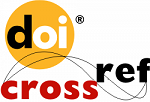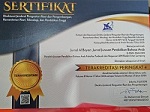The Characteristics of Teaching Material Arabic Speaking Skills in Higher Education
Abstract
Keywords
Full Text:
PDFReferences
Al-Naqah, Mahmud Kamil, تعليم اللغة العربية لناطقين بالغة الأخرى: أسوسه، مداخله، طروق تدريسه (مكة المكرمة: جامعة الأم القرى)
Amerian, Majid, and Sajjad Pouromid, ‘Language Teachers’ Beliefs on Materials Use And Their Locus Of Control: Case-Studies From Iran And Japan’, International Journal of Applied Lingustics, 7.3 (2018)
Brown, H. Douglas, Principle of Language Learning and Teaching (New York: Prentice Hall)
Dajani, Basma Ahmad Sedki, Salwa Mubaideen, and Fatima Mohammad Amin Omari, ‘Difficulties of Learning Arabic for Non-Native Speakers’, Procedia - Social and Behavioral Sciences, 114 (2014), 919–26
Dajani, Basma Ahmad Sedki, and Fatima Mohammad Amin Omari, ‘A Critical Study of Three Textbooks for Teaching Arabic to Non-Native Speakers’, Procedia - Social and Behavioral Sciences, 114 (2014), 476–81
Elyas, Tariq, and Michelle Yvette Picard, ‘Teaching and Moral Tradition in Saudi Arabia: A Paradigm of Struggle or Pathway Towards Globalization?’, Procedia - Social and Behavioral Sciences, 47 (2012), 1083–86
Fadhlullah, Muhammad Rajab, الاتجاهات التربيوية المعاصرة في تدريس اللغة العربية, ed. by عالم الكتب (القاهرة, 2003)
Ghani, Kamarulzaman Abd., Nik Mohd Rahimi Nik Yusof, Harun Baharuddin, Hamidah Yamat, Zamri Ahmad, and Ibtisam Abdullah, ‘Development of a Learning Module on Arabic Language Skills Outside of the Classroom’, Procedia - Social and Behavioral Sciences, 18 (2011), 154–62
Graves, Kathleen, Designing Language Courses: A Guide for Teachers (Canada: Heinle & Heinle Publishers, 2000)
Hendri, Muspika, ‘Pembelajaran Keterampilan Berbicara Bahasa Arab Melalui Pendekatan Komunkatif’, POTENSIA: Jurnal Kependidikan Islam, 3.2 (2017), 196
Istitih, Samir Syarif, ‘علم اللغة التعلمي’ (الأردن: دار العمال), pp. 141–42
Jamous, Rawya, and Abdul Rahman Chik, ‘Teaching Arabic for Cultural Purposes: A Case Study of Francophone Program of Arabic at Aleppo University’, Procedia - Social and Behavioral Sciences, 66 (2012), 37–45
Kataw, Yasmine, ‘Teaching Arabic as a Foreign Language: The Role of Communicative Competence , Pragmatics, and Literacy’, 2016
Kholisin, ‘Pembelajaran Kalam Berbasis Phonetic Accuracy Untuk Meningkatkan Kemampuan Berbicara Bahasa Arab’, Jurnal Bahasa, Sastra, Seni Dan Pengajaran, 43.2 (2015), 143–53
Mahmoodi, Mohammad-Hadi, and Ismail Moazam, ‘Willingness to Communicate (WTC) and L2 Achievement: The Case of Arabic Language Learners’, Procedia - Social and Behavioral Sciences, 98 (2014), 1069–76
Manshur, Mahmud, الإستماع والحوار فنون المقابلة المثالية (الأردن: دار اليفى العلمية, 2013)
Mendelsohn, D.J, and J Rubin, A Guide for The Teaching Of Second Language Listening (Dominie Press, 1995)
Nasir, Laeth S., and Arwa K. Nasir, ‘Introducing Arabic Language Patient Education Materials in Jordan’, Patient Education and Counseling, 60.2 (2006), 142–45
Prasetyo, Bambang, Metode Penelitian Kuantitatif (Jakarta: RajaGrafindo Persada, 2005)
Prastowo, Andi, Panduan Kreatif Membuat Bahan Ajar Inovatif (Yogyakarta: Diva Press, 2016)
Rahmaini, ‘Strategi Pembelajaran Maharah Kalam Bagi Non-Arab’, Ihya Al-Arabiyah: Jurnal Pendidikan Bahasa Dan Sastra Arab, 1.2 (2015), 227–33
Rasyid, Yumna, and Puti Zulharby, ‘Developing Syllabus of Arabic Language Productive Competence Based on Content Language Integrated Learning (Clil)’, Ijer - Indonesian Journal of Educational Review, 4.1 (2017), 153
Richard, Jack C., and Willy A Renandya, Methodology in Language Teaching: An Anthology of Current Practice (New York: Cambridge University Press, 2002)
Richards, Jack C., and Manel Lacorte, Book Reviews : Curriculum Development in Language Teaching, RELC Journal (United Stated of America: Cambridge University Press, 2007), XXXIII
Roviin, Roviin, ‘Analisis Buku Teks Al ‘Arabiyah Li Al Nasyi’in Karya Mahmud Ismail Shini, Dkk’, Jurnal Al Bayan: Jurnal Jurusan Pendidikan Bahasa Arab, 10.01 (2018), 36–53
Sirajudeen, Adam, and AbdulWahid Adebisi, ‘Teaching Arabic as a Second Language in Nigeria’, Procedia - Social and Behavioral Sciences, 66 (2012), 126–35
Smaldino, Sharon, Instruksional Technology & Media for Learning (Jakarta: Kencana Prenada Media, 2011)
Syaifullah, Muhammad, and Nailul Izzah, ‘Kajian Teoritis Pengembangan Bahan Ajar Bahasa Arab’, Arabiyatuna : Jurnal Bahasa Arab, 3.1 (2019), 127
Wahab, Muhbib Abdul, ‘Standarisasi Kurikulum Pendidikan Bahasa Arab Di Perguruan Tinggi Keagamaan Islam Negeri’, Jurnal Pedidikan BAhasa Arab Dan Kebahasaaraban, 3.1 (2016), 32–51
Yaqub, Muhammad Tunde, ‘Developing Speaking Skill in Arabic Learners: A Proposal for Integration of Product and Proces Approaches’, European Scientific Journal, 8.29 (2012), 140–49
Yasim, Irma Martiny Md., Maimun Aqsha Lubis, Zaid Arafat Mohd Noor, and Mohd Yusri Kamarudin, ‘The Use of Teaching Aids in the Teaching and Learning of Arabic Language Vocabulary’, Creative Education, 07.03 (2016), 443–48
Zedan, Ashraf M., Fakhrul Adabi Bin Abdul Kadir, Mouhammed Bin Yusof, Yusmini Binti Md Yusoff, Norrodzoh Binti Hj Siren, Roslan Bin Mohamed, and others, ‘The Role of Language in Education: Arabic as Case Study’, Procedia - Social and Behavioral Sciences, 70 (2013), 1002–8
DOI: http://dx.doi.org/10.24042/albayan.v11i2.5175
Refbacks
- There are currently no refbacks.
Copyright (c) 2019 Jurnal Al Bayan: Jurnal Jurusan Pendidikan Bahasa Arab
License URL: https://creativecommons.org/licenses/by-sa/4.0
Editorial Office:
Jurnal Al Bayan: Jurnal Jurusan Pendidikan Bahasa Arab, Arabic Education Study Program, Faculty of Education and Teachers Training, Unversitas Islam Negeri Raden Intan Lampung
Jl. Endro Suratmin 1 Sukarame, Bandar Lampung 35131-Indonesia
e-mail: jurnalalbayan@radenintan.ac.id
http://ejournal.radenintan.ac.id/index.php/albayan/index
Jurnal Al Bayan: Jurnal Jurusan Pendidikan Bahasa Arab is licensed under a Creative Commons Attribution-ShareAlike 4.0 International License. p-ISSN 2086-9282 | e-ISSN 2549-1229









